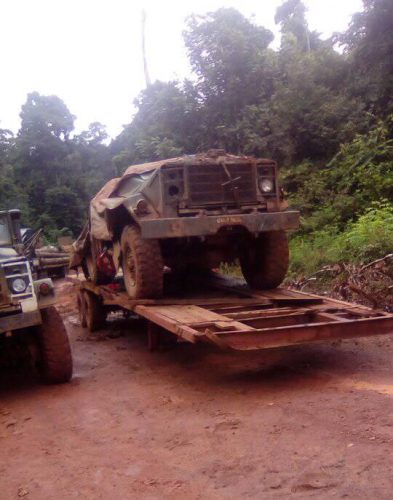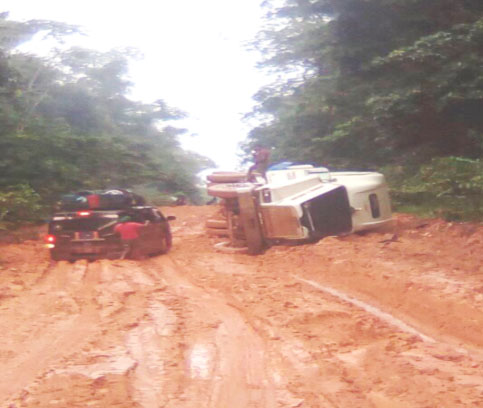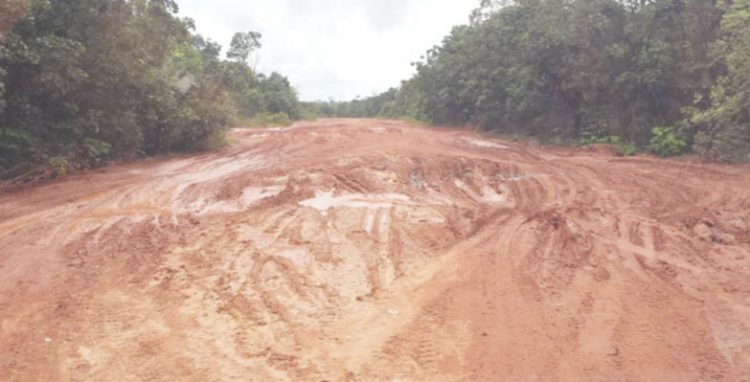The continuous deterioration of the Linden-Lethem Road is said to be hampering the flow of money in the Region, as financial hardships have fallen on various sectors in the Rupununi.
For years, drivers, both private and commercial, who traverse the road, have been left at the mercy of the elements as they battle the poor road conditions.
This rainy season has proven to be no different, as the calls for a solution to the almost impassable roads have been met with promises to have works commence at the end of the rainy season, or reminders that government has since signed a Memorandum of Understanding for the construction of the Linden-Lethem Road.
Be that as it may, for many it does not take away from the challenges they currently face as it relates to trying to sustain their livelihoods during a period they often refer to as “hard guava season.”
Stabroek News has for the past few days engaged a number of persons who are familiar with the situation through their own experiences with the road and its effects on life in the region.
Among those who spoke with this newspaper was Sebastian De Freitas, a young entrepreneur, whose position on the issue remains that regular maintenance of the road is needed.
“They are building roads that have to be maintained regularly. They do not do enough compacting, they do not do enough maintenance. This is a road through an area that is very, very vulnerable to the elements,” De Freitas said.
“Contractors need to implement better ways of building the road, and if not, they have to put pressure on those who give them more money if that’s their complaint,” he added, before noting that he would not object to a slight increase in tolls once he is able to traverse a good road.
Sharing his own personal experience of how the deplorable road conditions have affected tourism in the region, De Freitas explained that just a few weeks ago he had to cancel an overland tour paid for by an overseas couple because of the condition of the road.
“I didn’t expect the road to get so bad so quickly. I had to tell them, listen I have to be honest that the road is very, very bad and I don’t think you would enjoy the trip. These were tourists who were bringing in business for at last three or four lodges in the area, but we all lost out on that because of the roads. It didn’t even make sense to fly into Lethem, because from Lethem to our place, what used to take an hour and a half, is now taking about four and a half hours,” De Freitas said.
“Another thing, before the buses would leave Georgetown at 6 pm and at 1.00 [am], maybe 2.00 am they are at Kurupukari, where passengers would usually pay $500 to use a hammock to sleep in. Now, because of the road, the buses not reaching there until five or six in the morning, and so the people at Kurupukari don’t have anything to get, because buses just drive straight to the crossing and wait. It is hampering the flow of money in the region, money is now being put into maintenance costs and time wasted unnecessarily,” he added.
Other spin-off effects of the road situation are to be seen in the cost of food supplies which make their way from Georgetown to Lethem.
Changing parts
“Truck drivers generally carry a lot of load and continue to add more to get more dollar per load and they will continue to do so as the road deteriorates, because they will have to spend more money on changing parts. Some truckers charge more simply because the road is so bad and they have maintenance costs, so you would find some people charging more to get food up there. With all of this, it makes more sense to buy out of Brazil and so monies end up being spent elsewhere,” De Freitas outlined, before adding that the same thing applies to construction materials.
“Almost every week there are about three to four tankers going into Lethem and that basically shows you the consumption of fuel, and this is Lethem alone. Tankers also drop off to Annai and it is shuttled to other villages and mining areas. Now fuel price raise, that’s one lash, the second lash is if something happens and the tanker cannot get fuel in fast enough then you end up with a fuel shortage and automatically things raise. Financially things are very, very difficult during this time,” he added.
De Freitas also shared his belief that the current state of the road continues to ward off potential investors from neighbouring Brazil.
“The transfer of goods from Guyana to Brazil and Brazil to Guyana is already very difficult to do, and the goods that I bring in, the companies I work with are having issues with being able to deliver stuff on time. Last year I brought in 60 tonnes of goods for companies, it was supposed to take two days to reach, but ended up taking nine days instead. Because I live in Brazil, I know quite a few investors who want to do business in Guyana, but they can’t for the simple fact that the road is so bad,” he explained.
A similar cry of frustration was shared by a driver who operates a passenger bus along the Linden-Lethem Road as he explained that he is forced to service his bus every time he completes a trip on the road.
According to the man, what is usually a 12-hour journey from Georgetown to Lethem has now turned into a 15-hour, and sometimes even an 18-hour drive.
He also noted that in addition to the extended time spent on the road, he is now forced to service his bus after almost every trip, a task which attracts a steep cost.
“Every trip I mek, I got to service and with the condition of the road I just spend nearly $200,000 on my bus, because parts are very expensive, plus I got to pay mechanic,” the man added.
Notwithstanding his personal struggles, the driver explained to Stabroek News that as the road continues to deteriorate, the frequency of accidents on the trail has increased.
He explained that both trucks and minibuses are suffering, while noting that at least two trucks “turn over” on the road every day while trying to manoeuvre holes and bridges.
Over the past two weeks, this newspaper has reported on incidents where trucks have toppled and caused severe damage to two bridges, one of which is seen as the key access bridge to the South Rupununi.
Meanwhile, last Friday, the Ministry of Natural Resources (MNR), announced that an estimated $640 million has been allocated for works on the Linden-Lethem Road. These works, however, will not commence until the end of the rainy season.
The Ministry, in the statement, explained that with the support of the Guyana Geology and Mines Commission (GGMC), along with the Ministry of Public Infrastructure, there will be a collaborative effort moving forward, with the maintenance of several roads in the hinterland, at the end of the rainy season.
In the statement, it was noted that on May 30, six road contracts valued over $650 million had been awarded to various contractors for the maintenance of the Rockstone-Mabura, Kurupukari-Annai-Lethem and the Linden-Ituni-Kwakwani Roads. This was in addition to a previous contract awarded to JR Ranch for the Manari Bridge approach realignment in Region Nine, Rupununi, valued at $83,003, 620.
Further, it was explained that the rehabilitation of the Linden-Ituni- Kwakwani Road, Region Ten, will recommence at the end of the May-June rainy season, as GGMC, through the MNR, had awarded the contract for the repairs to the road to International Imports and Supplies to the tune of $239.7 million. The contractor has mobilized equipment at site and marking out of the road has commenced.
Also in Region Ten, maintenance of the Rockstone-Mabura Road is expected to commence at the end of the rainy season, with an estimated $140.4 million contract having been awarded to MMC Inc. for this project.
Similarly, maintenance of the Annai to Lethem Road should commence in the first week of June pending suitable weather.
Stabroek News understands that a contract for $139.3 million was awarded to D&R Construction and Machinery Rental on May 3, 2018, and that the contractor has submitted all bonds and the mobilization advance is being processed.
The contract for the continuing section of the road from Annai to Kurupukari was awarded on the same date to MMC Inc. and work was scheduled to commence in the final week of May.
The re-alignment of the Manari Bridge approach is also expected to start at the end of the rainy season. This re-alignment has become necessary following several accidents, and follows a promise made by government to intervene to preserve lives and limbs, the Ministry said in its statement.




